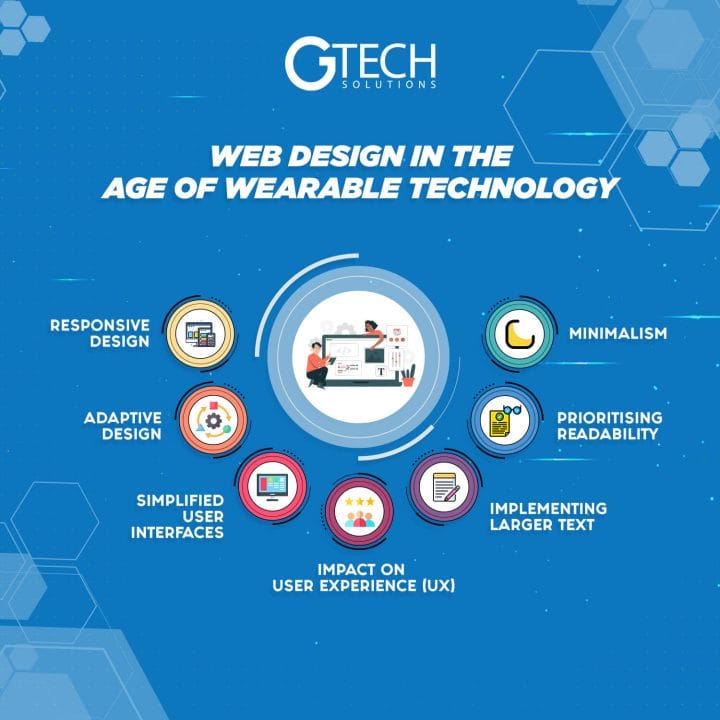
How will wearable technology affect web design in 2024?
Imagine you could access the web from anywhere, anytime, without using your hands or eyes.
Imagine you could get instant information, communication, entertainment, and education from a device that fits on your wrist, your ear, or your face.
Imagine you could experience the web in a whole new way, with new possibilities and challenges. This is not a fantasy. This is wearable technology. And it is changing the web design landscape.
How will wearable technology affect web design? Read on and find out.
Why is wearable technology fast growing?
There are Two main reasons of why wearable technology is growing so fast:
Consumer Demand
People want health and wellness products that can track and improve their well-being. Wearable devices can monitor and train users on various health metrics and motivate them to stay fit.
Technology innovation
Wearable devices are becoming smarter, faster, and easier to use thanks to new technologies like 5G, AI, AR, and biometrics. These technologies enable wearable devices to offer users new features and experiences, such as voice, gesture, immersion, and biometrics.
Wearable technology is rapidly developing in web designing as it creates new challenges and opportunities for creating websites that can adapt to the different screen sizes, shapes and functionality of wearable devices. Web designers need to use responsive design, minimalism and user-centred design principles to create websites that provide a good user experience on wearable devices.
Responsive Design
Responsive design is when your website changes its layout and content according to the device’s screen size, shape, and orientation. You can use flexible grids, media queries, and breakpoints to make your website responsive. This way, your website can adjust to any screen resolution and aspect ratio.
Adaptive Design
Adaptive design is when your website has different versions for different devices. You can use device detection, server-side scripting, and conditional loading to make your website adaptive. This way, your website can deliver the best user experience for each device.
Simplified user interfaces
Wearable devices, such as smartwatches and smart glasses, have small screens that can only show a limited amount of information and interactions.
Web designers have to think carefully about what is most important for the user and how to present it on wearable screens. They have to avoid unnecessary elements, choose fonts that are easy to read, and use short and clear messages to communicate with the user.
They also have to make use of interactions that are suitable for wearable devices, such as tapping or voice commands, to make the user experience more engaging and convenient. These are some of the web design principles for wearable tech that are explained in the web search results.
Minimalism
Minimalism is a web design style that aims to reduce visual and cognitive load by using simple and clean elements, such as colours, shapes, icons and animations.
Minimal web design can help users focus on the most important information and actions on wearable devices, which have limited screen space and input options. Minimal web design can also improve the performance and battery life of wearable devices, as it reduces the amount of data and resources required to load and render web pages.
Prioritising Readability
Readability is important for wearable devices given their small screens and changing lighting conditions. Web designers focus on clear, crisp text and images with strong contrast. They use appropriate font size, line height and spacing for easy scanning. Improvements include using plain language, avoiding jargon, and providing clear feedback for a better user experience.
Implementing Larger Text
Large text is essential for web design for wearable devices. It improves readability, accessibility, and usability for users with limited screen space, low vision, or high distraction. Web designers should use relevant units, clear fonts, contrast, spacing, alignment and plain language for large text.
Impact on User Experience (UX)
Wearable technology in web design can enhance or hinder the user experience (UX). It can offer convenience, personalization and interactivity for users who want to access web content on the go.
However, it can also present challenges, such as limited battery life, privacy issues, and compatibility issues. Web designers must consider the needs, preferences, and expectations of wearable technology users and design web content accordingly.
Conclusion
Consider the ethical and social implications of wearable technology on privacy, security, and human dignity.
G-Tech Sol, a responsive web design agency, integrates the latest in wearable tech into its projects. For website design or digital marketing needs, contact G-Tech Sol.
Our services are in sync with wearable technology and emerging trends. Whatever your goal, we guide you there. Contact us today to see how we can enhance your web presence with wearable technology.




